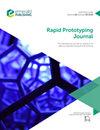熔丝制造3D打印方法的温度分布模拟
IF 3.6
4区 工程技术
Q1 ENGINEERING, MECHANICAL
引用次数: 0
摘要
摘要温度是熔丝制造(FFF)过程中的一个关键因素,它影响熔丝的流动行为和粘附性以及最终制品的力学性能。因此,在FFF中建模和预测温度对于实现高质量打印、可重复性、过程控制和故障预测至关重要。本文采用不同的丙烯腈-丁二烯-苯乙烯单链样品,通过数值和实验研究了熔体在FFF中的沉积和温度分布。改变工艺参数,包括层厚、喷嘴温度和构建平台温度。设计/方法/方法使用COMSOL Multiphysics软件对打印链进行流体流动和传热的数值模拟。利用连续方程、运动方程和水平集方程耦合跟踪聚合物熔体/空气界面,并利用传热方程模拟沉积链内的温度分布。数值结果表明,增加喷嘴温度或层厚会导致喷嘴附近温度升高,但床层温度是低厚度股管内整体层温的主要决定因素。利用红外热像仪测量了沉积链的实验温度分布,验证了数值结果。数值模拟与不同温度点的实测温度对比表明,该数值模型能够准确预测不同条件下单链三维打印过程中的传热。最后,进行了参数分析,以研究所选参数对打印链热历史的影响。数值结果表明,增加喷嘴温度或层厚会导致喷嘴附近温度升高,但床层温度是低厚度股管内整体层温的主要决定因素。利用红外热像仪测量了沉积链的实验温度分布,验证了数值结果。数值模拟与不同温度点的实测温度对比表明,该数值模型能够准确预测不同条件下单链3D打印过程中的传热。最后,进行了参数分析,以研究所选参数对打印链热历史的影响。本文章由计算机程序翻译,如有差异,请以英文原文为准。
Simulation of temperature profile in fused filament fabrication 3D printing method
Purpose Temperature is a critical factor in the fused filament fabrication (FFF) process, which affects the flow behavior and adhesion of the melted filament and the mechanical properties of the final object. Therefore, modeling and predicting temperature in FFF is crucial for achieving high-quality prints, repeatability, process control and failure prediction. This study aims to investigate the melt deposition and temperature profile in FFF both numerically and experimentally using different Acrylonitrile Butadiene Styrene single-strand specimens. The process parameters, including layer thickness, nozzle temperature and build platform temperature, were varied. Design/methodology/approach COMSOL Multiphysics software was used to perform numerical simulations of fluid flow and heat transfer for the printed strands. The polymer melt/air interface was tracked using the coupling of continuity equation, equation of motion and the level set equation, and the heat transfer equation was used to simulate the temperature distribution in the deposited strand. Findings The numerical results show that increasing the nozzle temperature or layer thickness leads to an increase in temperature at points close to the nozzle, but the bed temperature is the main determinant of the overall layer temperature in low-thickness strands. The experimental temperature profile of the deposited strand was measured using an infrared (IR) thermal imager to validate the numerical results. The comparison between simulation and observed temperature at different points showed that the numerical model accurately predicts heat transfer in the three-dimensional (3D) printing of a single-strand under different conditions. Finally, a parametric analysis was performed to investigate the effect of selected parameters on the thermal history of the printed strand. Originality/value The numerical results show that increasing the nozzle temperature or layer thickness leads to an increase in temperature at points close to the nozzle, but the bed temperature is the main determinant of the overall layer temperature in low-thickness strands. The experimental temperature profile of the deposited strand was measured using an IR thermal imager to validate the numerical results. The comparison between simulation and observed temperature at different points showed that the numerical model accurately predicts heat transfer in the 3D printing of a single-strand under different conditions. Finally, a parametric analysis was performed to investigate the effect of selected parameters on the thermal history of the printed strand.
求助全文
通过发布文献求助,成功后即可免费获取论文全文。
去求助
来源期刊

Rapid Prototyping Journal
工程技术-材料科学:综合
CiteScore
8.30
自引率
10.30%
发文量
137
审稿时长
4.6 months
期刊介绍:
Rapid Prototyping Journal concentrates on development in a manufacturing environment but covers applications in other areas, such as medicine and construction. All papers published in this field are scattered over a wide range of international publications, none of which actually specializes in this particular discipline, this journal is a vital resource for anyone involved in additive manufacturing. It draws together important refereed papers on all aspects of AM from distinguished sources all over the world, to give a truly international perspective on this dynamic and exciting area.
-Benchmarking – certification and qualification in AM-
Mass customisation in AM-
Design for AM-
Materials aspects-
Reviews of processes/applications-
CAD and other software aspects-
Enhancement of existing processes-
Integration with design process-
Management implications-
New AM processes-
Novel applications of AM parts-
AM for tooling-
Medical applications-
Reverse engineering in relation to AM-
Additive & Subtractive hybrid manufacturing-
Industrialisation
 求助内容:
求助内容: 应助结果提醒方式:
应助结果提醒方式:


